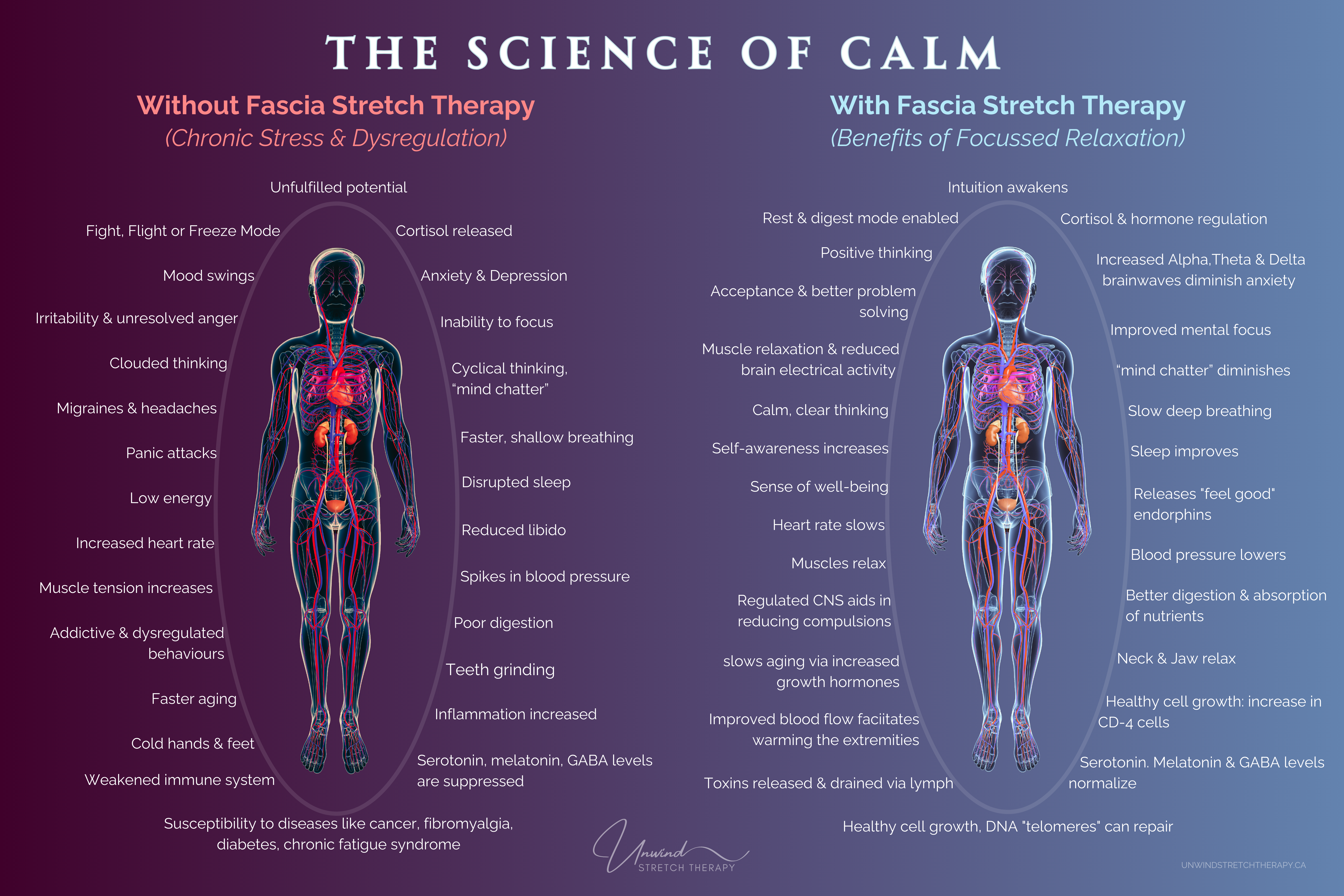In today’s fast-paced world, stress levels are at an all-time high. Global uncertainty—whether political, economic, or personal—can leave us feeling tense, anxious, and on edge. Our nervous systems are on high alert, stuck in a cycle of fight, flight or freeze. You may already have turned to some common stress-management strategies in an effort to regain balance.
Self-Care Practices to Reduce Stress
When life feels overwhelming, many people turn to self-care practices to help regulate their nervous system and restore a sense of calm. While no single approach works for everyone, the following techniques are widely recognized for their ability to ease stress and promote relaxation:
- Breathing Techniques – Deep, controlled breathing activates the parasympathetic nervous system, which helps shift the body out of fight-or-flight mode. Techniques like box breathing or diaphragmatic breathing can promote relaxation.
- Self-Stretching – Moving your body through gentle stretches can relieve muscle tension and improve circulation, helping you feel more at ease.
- Mindfulness & Meditation – By focusing on the present moment, these practices help train the mind to reduce the mental chatter that often fuels stress.
- Practicing Gratitude – Taking time to list the people, experiences, or moments you appreciate can create a positive shift in perspective, helping to counterbalance stress and anxiety.
- LifeStretch® or Yoga – These movement-based practices blend breath, flexibility, and mindfulness to improve mobility and encourage relaxation. For the purposes of this article, we’ll lump these two together, even though they are very different practices.
- Self-Massage & Myofascial Release – Techniques like foam rolling, self-percussion, or gentle self-massage can help release tension, improve circulation, and promote relaxation.
These techniques can be beneficial on their own or in combination with each other. However, if you’ve tried some or all of them and still find yourself struggling with tension, stiffness, or an overactive nervous system, you’re not alone. Sometimes, even self-care can feel like just another task on an already packed to-do list. But what if there was a way to break the stress cycle and shift into a state of calm—without the need for exercise, self-stretching, or complex mindfulness techniques?
Introducing FST™: Your Path to Deep Relaxation
 Fascia Stretch Therapy™ (FST) is more than just assisted stretching—it’s a highly specialized, science-backed method to help your body and mind unwind. Developed by Ann Frederick, a former dancer, and refined alongside her physiotherapist husband, Chris Frederick, FST was originally designed to enhance movement and recovery in high performing athletes. However, one of its most profound benefits is its ability to calm the nervous system, increasing circulation, lowering cortisol levels, and reducing inflammation.
Fascia Stretch Therapy™ (FST) is more than just assisted stretching—it’s a highly specialized, science-backed method to help your body and mind unwind. Developed by Ann Frederick, a former dancer, and refined alongside her physiotherapist husband, Chris Frederick, FST was originally designed to enhance movement and recovery in high performing athletes. However, one of its most profound benefits is its ability to calm the nervous system, increasing circulation, lowering cortisol levels, and reducing inflammation.
With stress at an all-time high, finding ways to truly relax is more important than ever.
The Beauty of Fascia Stretch Therapy
The best part? You don’t need to be a meditation master, a monk or even be flexible to experience the benefits.  With Fascia Stretch Therapy, you’re able to simply lie on the massage table and let a certified practitioner guide your body through effortless, flowing stretches. This effortless treatment is ideal for people of all ages and fitness levels, ranging from high performers to those with limited flexibility. In fact, many people find that after experiencing FST, they’re better able to practice other stress-reducing techniques with greater ease and effectiveness. That’s because FST naturally incorporates common stress-reduction techniques like breathing, gentle movement, and stretching—allowing you to experience these benefits without the pressure of maintaining a solo practice.
With Fascia Stretch Therapy, you’re able to simply lie on the massage table and let a certified practitioner guide your body through effortless, flowing stretches. This effortless treatment is ideal for people of all ages and fitness levels, ranging from high performers to those with limited flexibility. In fact, many people find that after experiencing FST, they’re better able to practice other stress-reducing techniques with greater ease and effectiveness. That’s because FST naturally incorporates common stress-reduction techniques like breathing, gentle movement, and stretching—allowing you to experience these benefits without the pressure of maintaining a solo practice.
The Science Behind the Calm
Unlike traditional stretching, which can sometimes activate the body’s stress response, FST works with your nervous system to encourage deep relaxation. It stimulates the parasympathetic nervous system—the part of your body responsible for rest and recovery—helping to:
- Lower cortisol levels, reducing stress and inflammation
- Improve circulation, delivering oxygen and nutrients more efficiently
- Ease muscle tension, helping your body release stored stress
- Promote better sleep, allowing for deeper rest and recovery

When the world feels chaotic, FST provides a structured, science-backed way to take control of your well-being. By incorporating regular FST sessions into your wellness routine, you’re not just taking care of your physical health—you’re investing in your longevity and mental well-being.
Why Now? The Importance of Nervous System Care in an Unstable World
We can’t always control what’s happening in the world around us, but we can take steps to support our own resilience. Chronic stress affects not only our mental state but also our physical health—leading to issues like fatigue, neck issues, tension headaches, back pain, and even digestive problems.
By incorporating regular FST sessions into your self-care routine, you’re actively working to:
- Enhance cognitive function, improving focus and mental clarity
- Prevent chronic pain, reducing stiffness and discomfort from prolonged stress
- Boost mood and emotional well-being, counteracting anxiety and depression
Your Journey to Resilience Starts Here
If you’ve tried stress-management techniques but still struggle with lingering tension, or if consistency has been a challenge, FST could be the missing link.
Taking care of yourself isn’t a luxury—it’s a necessity, especially in times of uncertainty. Whether you’re an athlete looking to improve recovery or someone simply trying to manage daily stress, FST offers a safe, effective, and effortless way to recalibrate your nervous system.
Life’s unpredictable—your self-care shouldn’t be. Prioritize your well-being and experience the power of FST for yourself.

Book a session with a Fascia Stretch Specialist at Unwind today and take the first step toward lasting stress relief




